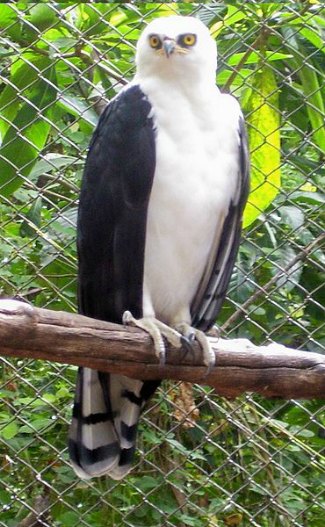Black-and-White Hawk Eagle - Spizaetus melanoleucus
By Mateus Hidalgo, CC-BY-SA-3.0, via Wikimedia Commons
Family: Accipitridae
Genus: Spizaetus
Species: S. melanoleucus
Black-and-White Hawk Eagles live in southern Mexico, Brazil, and Argentina. As their name would indicate, they are black and white in coloring, with a white body and black wings and face.
Physical Description:
Black-and-White Hawk Eagles have a black mask, shoulders, back, and a short, bushy black crest that forms a skullcap. The wings are dark-brown to black, and the tail is brown-gray with three or four black bands. The eyes are yellow, the cere is orange, and their beak has a black tip.
Juveniles are similar to adults, except they are browner and the tail bands are thinner.
Size:
Wingspan: 117 cm
Length: 51-61 cm
Weight: 750-780 g
Habitat and Distribution:
They occur in tropical and subtropical forest edges, gaps, and clearings in lowlands and foothills. They are also occasionally found in isolated woodland savannah. They occur most often at 0-1,700 meters above sea level, but they have been known to wander as high as 3,000 m.
They are found from 23°N to 28°S, from southern Mexico and Colombia, through eastern Brazil, to northeast Argentina and Paraguay. There are an estimated 10,000-100,000 individuals spread over 13,300,000 km².
Diet and Hunting:
They are known to eat mammals, amphibians, reptiles, and other birds such as passerines, toucans, wood-quails, and duck-hawks. They hunt by soaring in the canopy and diving to catch their prey.
Reproduction:
They nest in forest canopy, around 40 meters up, with a view of surrounding forest and open country. The nest is a cup-shaped structure made of sticks.
The clutch is 2 white, brown- and gray-spotted eggs.
Conservation:
Black-and-White Hawk Eagles have been listed as Least Concern by BirdLife International, due to their large range and apparent rate of decline.
Taxonomy:
Spizaetus melanoleucus was formerly considered part of its own monotypic genus Spizastur, but molecular studies of the DNA sequence of mitochondrial and nuclear genes have shown it is closely related to Spizaetus.
Other Names:
Hvidhovedet Høgeørn (Danish), Zwartre-witte Kuifarend (Dutch), Tanukotkas (Estonian), Töyhtövalkotka (Finnish), Aigle noir et blanc (French), Elsteradler (German), Spizastore bianco e nero (Italian), Segurokumataka (Japanese), Kalottørn (Norwegian), Wojownik bialoglowy (Polish), Gavião pato (Portuguese), Aguila azor Blanquinegra (Spanish), Svartvit hökörn (Swedish).
Video of a Black-and-White Hawk Eagle:
References:
http://www.avesderapinabrasil.com/spizaetus_melanoleucus.htm
http://avibase.bsc-eoc.org/species.jsp?avibaseid=EA4FB522AC938413
BirdLife International (2011) Species factsheet: Spizaetus melanoleucus. Downloaded from
http://www.birdlife.org on 23/08/2011.
Global Raptor Information Network. 2011. Species account: Black-and-white Hawk-eagle Spizaetus melanoleucus. Downloaded from
http://www.globalraptors.org on 23 Aug. 2011.
BirdLife International 2009. Spizaetus melanoleucus. In: IUCN 2011. IUCN Red List of Threatened Species. Version 2011.1.
www.iucnredlist.org. Downloaded on 23 August 2011.
Tate, Adam Robert. 2011. Black-and-white Hawk-Eagle (Spizaetus melanoleucus), Neotropical Birds Online (T. S. Schulenberg, Editor). Ithaca: Cornell Lab of
Ornithology; retrieved from Neotropical Birds Online:
http://neotropical.birds.cornell.edu/portal/species/overview?p_p_spp=129716
http://www.planetofbirds.com/accipitriformes-accipitridae-black-and-white-hawk-eagle-spizaetus-melanoleucus
Ferguson-Lees, James, and Christie, David A. Raptors of the World. Houghton Mifflin Company, 2001.
